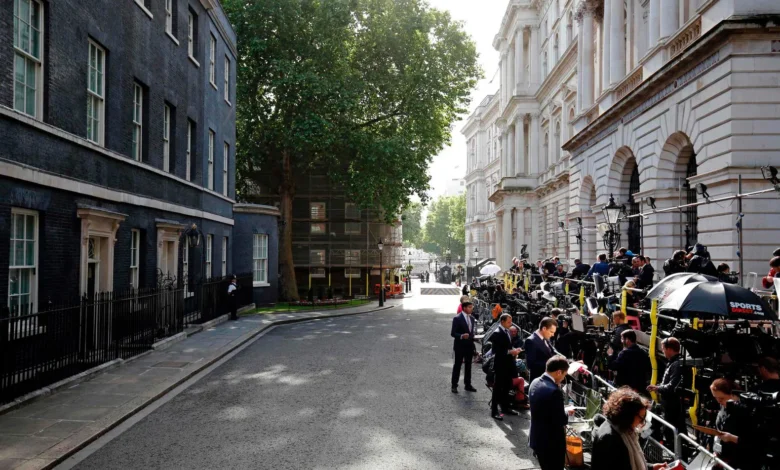
Nestled in the heart of Westminster, Downing Street stands as one of the most recognizable addresses in the world, synonymous with British political power and governmental authority. This modest Georgian terrace, stretching merely 200 meters in length, has been the epicenter of British politics for over three centuries, housing Prime Ministers, witnessing historic decisions, and serving as the backdrop for countless pivotal moments in British and world history.
The history of Downing Street is intrinsically woven into the fabric of modern British democracy, representing not just a physical location but a symbol of political stability, tradition, and governmental continuity. From its humble beginnings as a collection of townhouses built by Sir George Downing in the 1680s to its current status as the official residence of the British Prime Minister, Downing Street has evolved to become one of the most secure and significant political addresses globally.
What makes Downing Street particularly fascinating is its unique blend of accessibility and security, tradition and modernity. While the famous black door of Number 10 Downing Street has become an iconic symbol recognized worldwide, the street itself tells a much broader story of British political evolution, architectural heritage, and the changing nature of governance in a democratic society. This exploration will delve deep into the multifaceted significance of Downing Street, examining its historical development, architectural features, notable residents, and enduring impact on British political culture.
The Origins and Early History of Downing Street
Sir George Downing’s Vision
The story of Downing Street begins in the 1680s with Sir George Downing, a complex figure whose name would become forever associated with British political power. Downing, who served as a diplomat under both Oliver Cromwell and King Charles II, purchased the land that would eventually become Downing Street with ambitious plans for development. His vision was to create an elegant row of townhouses that would attract wealthy and influential residents to this prime Westminster location.
The Downing Street development was part of a broader urban expansion occurring in London during the late 17th century. Sir George Downing recognized the strategic importance of this location, situated between Westminster Palace and St. James’s Park, making it an ideal spot for those involved in government and court affairs. The original construction featured fifteen houses, though the exact architectural details of these early structures remain somewhat mysterious due to limited historical records.
Transformation into Government Residences
The transition of Downing Street from private residences to government buildings occurred gradually throughout the 18th century. King George II played a crucial role in this transformation when, in 1732, he offered Number 10 Downing Street to Sir Robert Walpole, who is widely recognized as Britain’s first Prime Minister. This generous royal gesture established a precedent that would fundamentally alter the significance of Downing Street in British political life.
Walpole’s acceptance of the royal offer came with an important stipulation that would shape the future character of the residence. Rather than accepting the property as a personal gift, Walpole insisted that it should belong to the office of First Lord of the Treasury, ensuring that future occupants would inherit the residence based on their governmental position rather than personal ownership. This decision established Number 10 Downing Street as an official government residence, setting it apart from other political addresses around the world.
Architectural Evolution and Design Features
Georgian Architecture and Structural Modifications
The Downing Street architecture represents a fascinating blend of original Georgian design and centuries of modifications, renovations, and security enhancements. The original structures built by Sir George Downing followed the typical Georgian townhouse pattern, featuring narrow frontages, multiple stories, and elegant proportions that were characteristic of late 17th and early 18th-century London residential architecture.
Over the centuries, Number 10 Downing Street has undergone numerous architectural transformations to accommodate the changing needs of government and the evolving security requirements of the Prime Minister’s residence. The most significant renovation occurred during the 1960s under Prime Minister Harold Wilson, when structural engineers discovered that many of the original foundations and supporting walls were in dangerous condition, requiring extensive reconstruction work that preserved the historic facade while completely rebuilding much of the interior structure.
The famous black door, perhaps the most recognizable feature of Downing Street, has become an iconic symbol of British political power. This door, which has been photographed countless times and serves as the backdrop for important political announcements, represents the intersection of accessibility and authority that characterizes British democratic governance. The door’s simple elegance, marked only by the number “10” and a brass door knocker, embodies the understated nature of British political tradition.
Interior Layout and Functional Spaces
The interior of Number 10 Downing Street reflects centuries of adaptation to serve both residential and governmental functions. The building contains approximately 100 rooms spread across multiple floors, including the famous Cabinet Room where crucial government decisions are made, the State Dining Room for official entertainment, and private residential quarters for the Prime Minister and their family.
The Downing Street layout has been carefully designed to accommodate the dual nature of the building as both a working government office and a private residence. The ground floor primarily serves official functions, housing reception areas, meeting rooms, and the famous entrance hall where visitors are received. The first floor contains the main state rooms, including the Cabinet Room and the study where the Prime Minister conducts much of their daily business, while upper floors provide private residential accommodation.
Political Significance and Role in British Governance
Center of Executive Power
The political significance of Downing Street extends far beyond its function as a mere residence, representing the very heart of British executive power and democratic governance. Number 10 Downing Street serves as the operational headquarters for the Prime Minister, housing not only the head of government but also crucial staff members, advisors, and the administrative apparatus necessary for running a modern democratic state.
Within the walls of Downing Street, some of the most important decisions in British and world history have been made. From Winston Churchill’s wartime leadership during World War II to Margaret Thatcher’s economic reforms in the 1980s, the building has witnessed pivotal moments that have shaped not only British society but global affairs. The Cabinet Room in particular has been the setting for countless meetings where policies affecting millions of people have been debated and decided.
The building’s role as a center of political communication cannot be overstated. The famous doorstep of Number 10 has become one of the most important political stages in the world, where Prime Ministers make crucial announcements, welcome foreign dignitaries, and address the nation during times of crisis. These appearances on the Downing Street doorstep have become a vital part of British political theater, providing a direct connection between the government and the people.
Symbol of Democratic Stability
Downing Street represents more than just political power; it embodies the continuity and stability of British democratic institutions. Unlike many other world capitals where government buildings are grand palaces or imposing structures designed to intimidate, Downing Street’s modest appearance reflects the British approach to democratic governance, emphasizing substance over spectacle and accessibility over grandeur.
The peaceful transfer of power that occurs regularly at Downing Street demonstrates the strength of British democratic traditions. When a new Prime Minister arrives at Number 10, they are continuing a tradition that stretches back nearly three centuries, joining a line of leaders who have grappled with the challenges of governance while maintaining democratic principles and constitutional norms.
Notable Residents and Historic Moments
Legendary Prime Ministers of Downing Street
Throughout its long history as the official Prime Minister’s residence, Downing Street has been home to some of the most influential and memorable leaders in British history. Each resident has left their mark on both the building itself and the broader course of British political development, contributing to the rich heritage of Downing Street.
Winston Churchill, perhaps the most famous resident of Number 10 Downing Street, led Britain through its darkest hour during World War II from these historic rooms. Churchill’s wartime leadership, characterized by stirring speeches and unwavering determination, was largely coordinated from the building’s underground bunker and various meeting rooms. His presence in Downing Street during this critical period has contributed significantly to the building’s legendary status in British national memory.
Margaret Thatcher, Britain’s first female Prime Minister, also left an indelible mark on Downing Street during her eleven-year tenure from 1979 to 1990. Known as the “Iron Lady,” Thatcher’s revolutionary economic policies and strong leadership style were developed and implemented from Number 10, making the building a symbol of her transformative approach to British governance and her significant impact on both domestic and international affairs.
Historic Events and Decisions
The walls of Downing Street have witnessed numerous pivotal moments in British and world history, from declarations of war to peace negotiations, from economic crises to diplomatic breakthroughs. The building has served as the nerve center for British responses to international crises, hosting emergency meetings during conflicts, economic downturns, and natural disasters.
One of the most significant historic moments associated with Downing Street occurred in 1940 when Churchill delivered many of his famous wartime speeches from the building, rallying the British people during the darkest days of World War II. The building’s role as a communication center during this period established its importance not just as a governmental headquarters but as a symbol of national resilience and determination.
Modern Security and Public Access
Balancing Security with Democratic Accessibility
The modern era has brought significant challenges to Downing Street, particularly regarding the balance between necessary security measures and maintaining the democratic principle of governmental accessibility. Following various security concerns and terrorist threats, Downing Street has been transformed from a relatively open public thoroughfare into one of the most secure government facilities in the world.
The installation of security gates at both ends of the street in 1989 marked a significant change in the character of Downing Street, creating a more fortress-like atmosphere while maintaining the street’s function as a working government district. These security measures, while necessary for protecting government officials, have altered the relationship between the government and the public, creating a physical barrier that some argue symbolically distances political leaders from the people they serve.
Despite these security enhancements, efforts have been made to maintain some degree of public engagement with Downing Street. Regular tours are offered to selected groups, allowing citizens to experience the historic interiors and understand the building’s role in British governance. These carefully managed visits help preserve the democratic tradition of governmental transparency while respecting necessary security requirements.
Cultural Impact and Global Recognition
Downing Street in Popular Culture
The cultural significance of Downing Street extends far beyond its political importance, having become a globally recognized symbol that appears frequently in literature, film, television, and other forms of popular culture. The distinctive black door of Number 10 has become one of the most photographed and recognizable government buildings in the world, symbolizing British political power and democratic governance to international audiences.
Television dramas, political thrillers, and historical documentaries regularly feature Downing Street as a setting, contributing to its mythical status in popular imagination. These cultural representations have helped cement the building’s place in global consciousness, making it instantly recognizable to people who may never visit London but understand its significance as a center of political power.
The building’s appearances in popular culture have also contributed to the broader “soft power” influence of British political traditions, presenting an image of governmental sophistication, historical continuity, and democratic stability that enhances Britain’s international reputation and diplomatic influence.
Conclusion
Downing Street stands as far more than a simple government building or Prime Minister’s residence; it represents the very essence of British political tradition, democratic governance, and historical continuity. From its origins as a speculative property development in the 1680s to its current status as one of the world’s most secure and significant government headquarters, Downing Street has evolved to embody the changing nature of British politics while maintaining its fundamental character as a symbol of democratic authority.
The history and significance of Downing Street reflects broader themes in British political development: the gradual evolution of democratic institutions, the balance between tradition and modernization, and the ongoing challenge of maintaining governmental accessibility while ensuring security. As Britain continues to navigate the complexities of modern governance, Downing Street remains a constant reminder of the nation’s political heritage and democratic values.
The enduring appeal of Downing Street lies in its unique combination of power and modesty, security and accessibility, tradition and adaptation. As future Prime Ministers continue to walk through its famous black door, they join a distinguished line of leaders who have shaped not only British history but the broader course of democratic governance worldwide. Downing Street will undoubtedly continue to serve as both a practical center of government and a powerful symbol of democratic leadership for generations to come.
Read More: The Oracle-OpenAI deal in 2025 the biggest cloud bet in AI history







